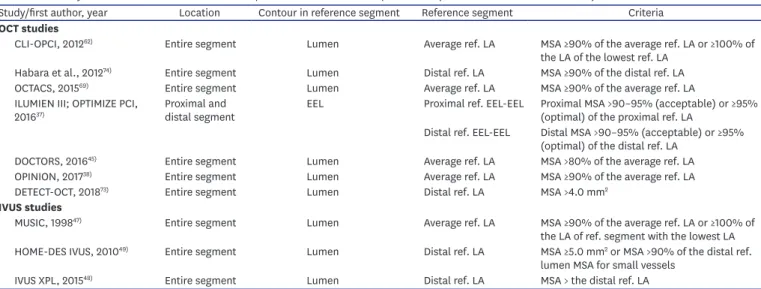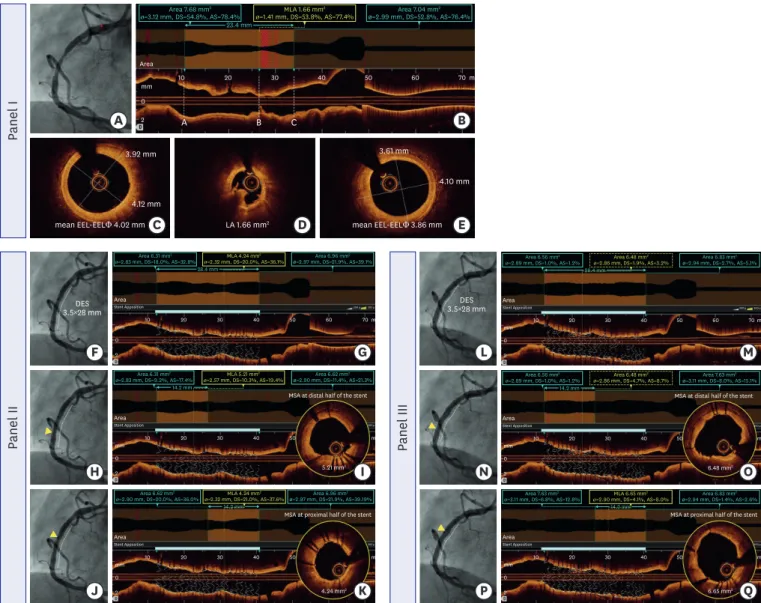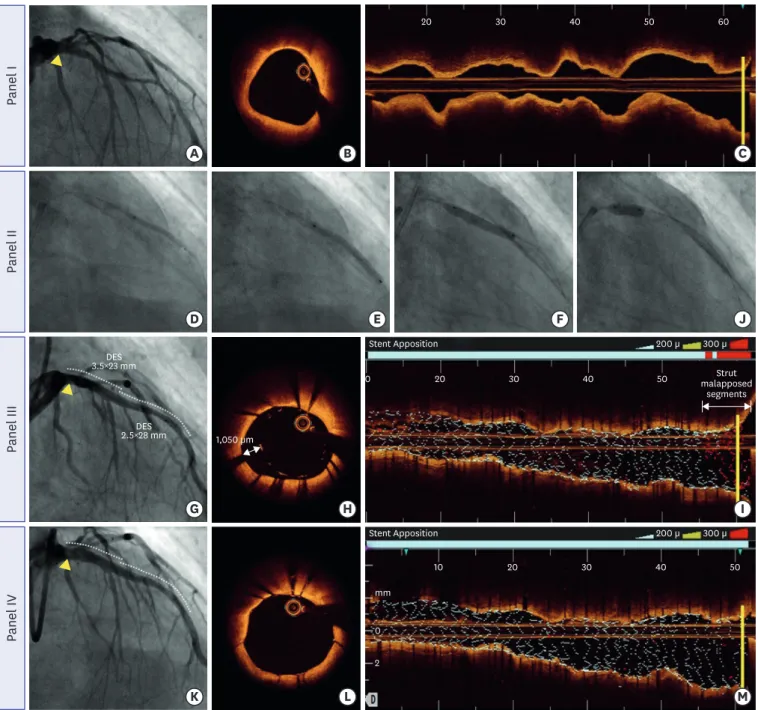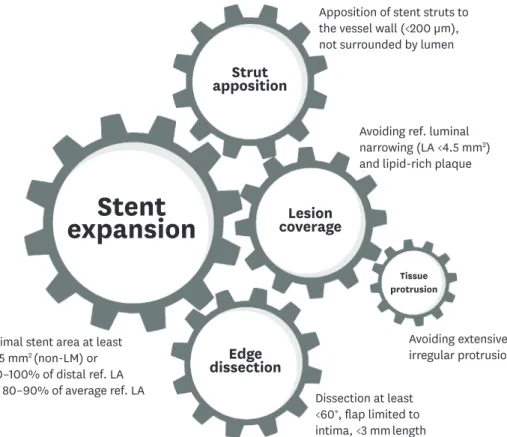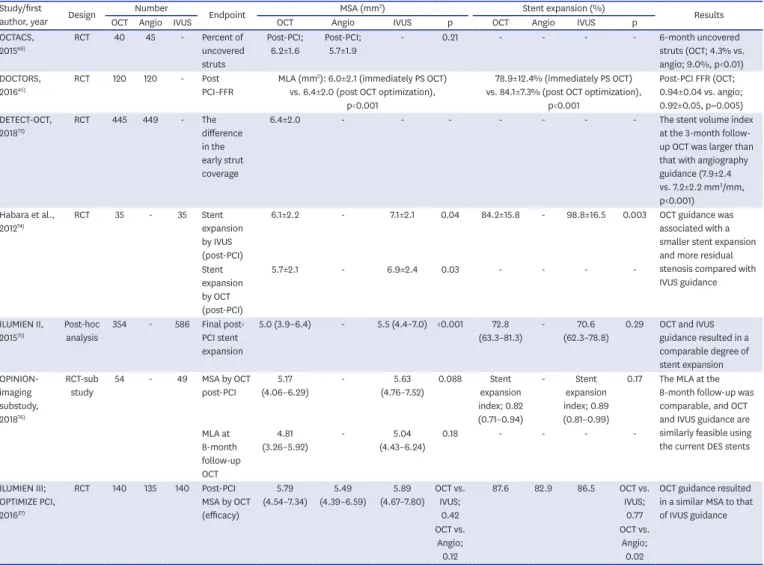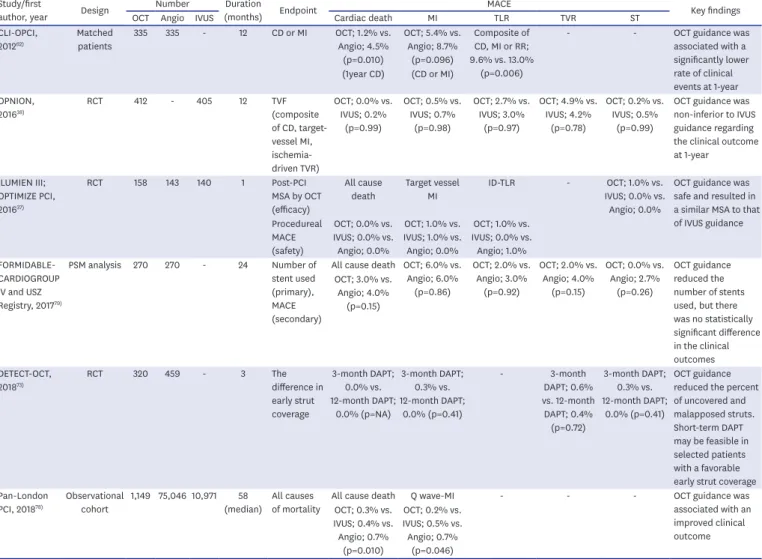ABSTRACT
Compared to the luminogram obtained by angiography, intravascular modalities produce cross-sectional images of coronary arteries with a far greater spatial resolution. It is capable of accurately determining the vessel size and plaque morphology. It also eliminates some disadvantages such as contrast streaming, foreshortening, vessel overlap, and angle dependency inherent to angiography. Currently, the development of its system and the visualization of coronary arteries has shown significant advancement. Of those, optical coherence tomography (OCT) makes it possible to obtain high-resolution images of intraluminal and transmural coronary structures leading to navigation of the treatment strategy before and after stent implantations. The aim of this review is to summarize the published data on the clinical utility of OCT, focusing on the use of OCT in interventional cardiology practice to optimize percutaneous coronary intervention.
Keywords: Coronary artery disease; Percutaneous coronary intervention;
Optical coherence tomography
INTRODUCTION
Despite the development of many technologies in the era of percutaneous coronary intervention (PCI) since its introduction in 1977, coronary angiography (CAG) is still used as a gold standard to diagnose coronary artery disease, determine the treatment strategy, and evaluate the therapeutic effect. However, it is also true that CAG has several limitations.
Therefore, the intravascular imaging method has been introduced to overcome the drawbacks of CAG. Intravascular ultrasound (IVUS) has better resolution than CAG. It provides a cross-sectional image and more information than CAG. Thus, it can broaden the horizon and understanding of coronary artery disease. IVUS findings provide important information to physicians before and after coronary stenting. For example, the minimal stent area (MSA) among the IVUS parameters is known to be a predictor of a long-term major adverse cardiovascular event (MACE). 1)2) Until now, IVUS-guided PCI has been classified as Class IIa for a left main (LM) PCI or stent optimization in the American College of Cardiology/
American Heart Association (ACC/AHA) and European Society of Cardiology (ESC) guidelines. 3)4) However, since a meta-analysis has proven its hard endpoint reduction effect
Review Article
Received: Jun 27, 2019 Accepted: Jul 3, 2019 Correspondence to Seung-Ho Hur, MD, PhD, FACC
Division of Cardiology, Department of Internal Medicine, Keimyung University Dongsan Hospital, 1035 Dalgubeol-daero, Dalseo-gu, Daegu 42601, Korea.
E-mail: shur@dsmc.or.kr
Copyright © 2019. The Korean Society of Cardiology
This is an Open Access article distributed under the terms of the Creative Commons Attribution Non-Commercial License (https://
creativecommons.org/licenses/by-nc/4.0) which permits unrestricted noncommercial use, distribution, and reproduction in any medium, provided the original work is properly cited.
ORCID iDs Cheol Hyun Lee
https://orcid.org/0000-0003-4203-1457 Seung-Ho Hur
https://orcid.org/0000-0002-3895-1915 Conflict of Interest
The authors have no financial conflicts of interest.
Author Contributions
Writing - original draft: Lee CH, Hur SH;
Writing - review & editing: Hur SH.
Cheol Hyun Lee , MD and Seung-Ho Hur , MD, PhD, FACC
Division of Cardiology, Department of Internal Medicine, Keimyung University Dongsan Hospital, Daegu, Korea
Optimization of Percutaneous
Coronary Intervention Using Optical
Coherence Tomography
including mortality, it tends to be used more often in practice or complex PCI procedures. 5)6) Currently, IVUS is regarded as an essential tool for PCI optimization in complex lesions.
Although intravascular optical coherence tomography (OCT) has a shorter history than IVUS, it has a 10 times higher resolution and provides more information than IVUS. In addition, the development of a user interface for OCT has led to a more accurate approach for stent optimization, including information on the stent expansion, edge dissections, stent apposition, and tissue protrusions (TPs). As the experience of OCT-guided PCI accumulates, the recommendation level of OCT for stent optimization in 2018 ESC/European Association for Cardio-Thoracic Surgery (EACTS) guidelines has been upgraded from Class IIb to Class IIa. 7) Therefore, this article reviews the details, methods, and clinical implications of OCT for PCI optimization.
LIMITATIONS OF CORONARY ANGIOGRAPHY
CAG is still accepted as a gold standard for the diagnosis and treatment of coronary artery disease. 8)9) However, CAG has a limitation as a luminogram in that it can only reveal a change in the lumen. It is difficult to identify changes that appear in the early stage of coronary artery disease with CAG because it can only detect the late process of atherosclerosis such as luminal stenosis. Another serious limitation of CAG is that it is prone to functionally overestimating or underestimating the lesion because only a secondary shadow image is examined (Figure 1). 9-11) It is also difficult to judge the degree of the lesion severity, especially of complex lesions such as diffuse long lesions, bifurcation lesions, and calcified lesions. More importantly, the lesion has to be assessed through visual estimation. Thus, the evaluation of the lesion is inevitably subjective and is prone to have various errors in evaluating target lesions, selecting the treatment strategy, and determining the treatment results through CAG guidance only.
A B
10 20 30 40 mm
diagonal
distal << 53.8 mm, 20.0 mm/sec
Figure 1. A representative case demonstrating a discrepancy between coronary angiography and OCT. The right anterior oblique cranial projection of the left coronary angiogram showing mild stenosis at an LAD bifurcation lesion (A). However, OCT clearly demonstrates a focal (2 mm length) lotus root-like lesion consisting of multiple cavities with septation, which was not seen by coronary angiography (B). Modified from Korean J Intern Med 2016;31:807-808.
LAD = left anterior descending; OCT = optical coherence tomography.
INTRAVASCULAR IMAGING
To compensate for the limitations of CAG, imaging modalities including IVUS and OCT have been developed for use in clinical practice. IVUS can provide a cross-sectional image of the vessel wall similar to the histological findings using high ultrasound frequencies of 20 to 50 MHz. 12) Thus, IVUS allows a qualitative and quantitative assessment of the lumen, plaque, and vessel in coronary atherosclerotic lesions. On the other hand, OCT can generate a tomographic image using backscattered infrared light with an axial resolution of 12–15 μm. 13) Similar to IVUS, OCT can also provide qualitative and quantitative information for the lesion. However, OCT has several advantages for PCI optimization. First, OCT provides more detailed features (such as the presence of thrombi, plaque erosions, and the cap thickness) of the vascular wall that IVUS cannot detect. Thus, OCT is a better choice for detecting vulnerable plaque. Second, the pullback speed of OCT is faster than that of IVUS. In addition, OCT provides an automated analysis of the minimal and maximal diameters and lumen dimension of the entire area. Moreover, OCT can automatically point to the position of the minimal lumen area (MLA) in the lesion. Third, OCT can provide a more accurate assessment of the interaction with the vessel wall and stent (e.g., stent apposition, stent coverage, TPs, and edge dissections) due to its superior axial and lateral resolution power. The OPUS-CLASS study 14) performed measurements of the coronary arteries using OCT, IVUS, and CAG. The mean minimum lumen diameter (MLD) measured by CAG was significantly smaller than that measured by OCT while the MLD measured by IVUS was significantly greater than that measured by OCT. Using a phantom model, it was found that the mean lumen area measured by OCT was the same as the actual lumen area. However, IVUS overestimated the lumen area compared to OCT (relative reference 10%), suggesting that OCT might be more accurate for assessing coronary lesions than IVUS or CAG. Our previous study 15) had also shown discrepancies among OCT, IVUS, and CAG measurements for a phantom coronary model and human coronary arteries within and adjacent to stented segments. The discrepancy between IVUS and OCT was less prominent, with each measurement showing a stronger correlation for the stented segment than that for the reference segment. That was probably because the stent struts provided a clear landmark for the lumen discrimination in both OCT and IVUS for stented segments. For a phantom model and human coronary arteries, for IVUS as compared to OCT, the lumen area was larger, particularly for non-stented segments than for stented segments. The lumen diameter measured by CAG was smaller than that measured by IVUS or OCT. Based on these two studies, the lumen area measured by OCT is likely to be smaller than that measured by IVUS, particularly for non-stented segments than stented segments. The lumen diameter measured by CAG was smaller than that measured by IVUS or OCT. In addition, OCT could accurately and quantitatively measure the coronary artery dimensions in the clinical setting with a high reproducibility. However, in the post-stent evaluation, the discrepancy between IVUS and OCT was insignificant.
OPTICAL COHERENCE TOMOGRAPHY PARAMETERS FOR PERCUTANEOUS CORONARY INTERVENTION GUIDANCE
Pre-intervention
The role of OCT in pre-intervention is for the lesion evaluation. The plaque composition may
guide the implementation of a preparation strategy. For vulnerable plaque such as that with a
large lipid content or thin cap, and expansive remodeling lesions, direct stenting is an option
without predilatation. Since calcified lesions may not be detected by CAG, 16) an OCT-guided
PCI might be needed. For calcified lesions, OCT can accurately quantitate both its extent and severity. Thus, it can help physicians make a decision regarding the use of rotablation or cutting balloon for the lesion preparation and the selection of the device. Compared to IVUS, OCT can analyze the depth of calcified lesions in addition to a circumferential arc. Therefore, OCT can precisely measure the calcified lesion area that is known to be associated with underexpansion of stents. 17-19) In addition, the detailed information provided by OCT can be used to guide a calcified lesion preparation. For example, balloon dilatation for calcified plaques with a low thickness and wide arc on OCT (with cut-off values of 0.67 mm and 227°, respectively) can lead to calcium fractures that are known to be associated with a better stent expansion. 17) Similarly, an OCT-based study showed that calcified lesions with a maximum angle of >180°, maximum thickness of >500 μm, and length of >5 mm had increased the risk of stent underexpansion. 20) However, the effect of calcified lesions on the outcomes of a clinical PCI remains unclear.
OCT-detected large proportions of lipid plaque and thin-cap fibroatheromas (TCFAs) are known to be associated with a peri-procedural myocardial infarction (MI). 21-27) Owing to the correlation between edge problems in-stent thrombosis (ST) and MACE, 26-34) it might be required to avoid reference segments with large proportions of lipid plaque, particularly those with TCFAs. If lipid is unavoidable in the reference segment, covering the entire lipid- rich plaque with a stent instead of ending the stent in the middle of a lipidic region has been suggested. 28-36) More importantly, either the external elastic lamina (EEL) or the lumen diameter at the reference segments measured by OCT can provide the roadmap for stent sizing. There are two representative studies related to stent sizing. The Observational Study of Optical Coherence Tomography in Patients Undergoing Fractional Flow Reserve and Percutaneous Coronary Intervention (ILUMIEN) III: OPTIMIZE PCI used an EEL-based stent sizing while the Optical Frequency Domain Imaging vs. Intravascular Ultrasound in Percutaneous Coronary Intervention (OPINION) used a lumen-based stent sizing (Table 1). In the ILUMIEN III trial, the maximum and minimum diameters of the EEL at the proximal and distal reference segments
Table 1. Summary of the absolute and relative stent expansion criteria for stent optimization (data from IVUS and OCT studies)
Study/first author, year Location Contour in reference segment Reference segment Criteria
OCT studies
CLI-OPCI, 2012
62)Entire segment Lumen Average ref. LA MSA ≥90% of the average ref. LA or ≥100% of the LA of the lowest ref. LA
Habara et al., 2012
74)Entire segment Lumen Distal ref. LA MSA ≥90% of the distal ref. LA
OCTACS, 2015
69)Entire segment Lumen Average ref. LA MSA ≥90% of the average ref. LA
ILUMIEN III; OPTIMIZE PCI,
2016
37)Proximal and
distal segment EEL Proximal ref. EEL-EEL Proximal MSA >90–95% (acceptable) or ≥95%
(optimal) of the proximal ref. LA
Distal ref. EEL-EEL Distal MSA >90–95% (acceptable) or ≥95%
(optimal) of the distal ref. LA
DOCTORS, 2016
45)Entire segment Lumen Average ref. LA MSA >80% of the average ref. LA
OPINION, 2017
38)Entire segment Lumen Average ref. LA MSA ≥90% of the average ref. LA
DETECT-OCT, 2018
73)Entire segment Lumen Distal ref. LA MSA >4.0 mm
2IVUS studies
MUSIC, 1998
47)Entire segment Lumen Average ref. LA MSA ≥90% of the average ref. LA or ≥100% of
the LA of ref. segment with the lowest LA HOME-DES IVUS, 2010
49)Entire segment Lumen Distal ref. LA MSA ≥5.0 mm
2or MSA >90% of the distal ref.
lumen MSA for small vessels
IVUS XPL, 2015
48)Entire segment Lumen Distal ref. LA MSA > the distal ref. LA
Average ref. LA = (proximal + distal) reference LA/2; CLI-OPCI = Centro per la Lotta Contro L'Infarto-Optimization of Percutaneous Coronary Intervention;
DETECT-OCT = DETErmination of the Duration of the Dual Antiplatelet Therapy by the Degree of the Coverage of The Struts on Optical Coherence Tomography;
DOCTORS = Does Optical Coherence Tomography Optimize Results of Stenting; EEL = external elastic lamina; ILUMIEN = Observational Study of Optical Coherence Tomography in Patients Undergoing Fractional Flow Reserve and Percutaneous Coronary Intervention; HOME-DES IVUS = Long-Term Health Outcome and Mortality Evaluation After Invasive Coronary Treatment using Drug Eluting Stents with or without the IVUS Guidance; IVUS = intravascular ultrasound; IVUS XPL = The Impact of Intravascular Ultrasound Guidance on Outcomes of Xience Prime Stents in Long Lesions; LA = lumen area; MLA, minimal lumen area; MSA
= minimal stent area; MUSIC = Multicenter Ultrasound Stenting in Coronaries; OCT = optical coherence tomography; OCTACS = Optical Coherence Tomography
Guided Percutaneous Coronary Intervention With Nobori Stent Implantation in Patients With Non–ST-Segment–Elevation Myocardial Infarction; OPINION =
Optical Frequency Domain Imaging vs. Intravascular Ultrasound in Percutaneous Coronary Intervention; PCI = percutaneous coronary intervention.
were measured and the mean EEL diameter of each reference was calculated. The smaller of the two mean EEL diameters was rounded down to the nearest 0.25 mm to derive the stent diameter (e.g., 3.40 mm round down to 3.25 mm). 37) In the OPINION trial, the cross-sections that were close to the target lesion with the most normal appearance that had no lipidic plaque were set as the proximal and distal reference sites. After measuring the lumen diameter at the proximal and distal reference sites, the stent diameter was then calculated. The stent length was determined as the distance between the proximal and distal reference segments. 38) A representative case and illustration of the stent sizing are shown in Figures 2 and 3, respectively.
Intriguingly, the OPTIS integrated (OPTISi) angiographic co-registration system consists of the tracking radiopaque lens marker of the OCT catheter on a cine acquired during the OCT pullback. The software of the OPTISi system directly displays a matched side-by-side view of the OCT and angiography in the cath lab and eliminates the need for the currently used stand- alone, mobile OCT carts. A small white marker is directly projected onto the angiogram to pinpoint the corresponding site of the displayed OCT frame. Co-registration allows “mapping”
of coronary lesions on the angiographic roadmap (error margin approximately 1 mm). By using the OPTIS system, the stent length and location of the plaque can be linked to the angiography findings. It can be performed to carry out a more accurate intervention (Figure 4). 39)
Post-intervention
Stent underexpansion is an important risk factor of stent failure. 40)41) Stent expansion refers to the minimum cross-sectional area (CSA) of a stent as an absolute measurement (absolute stent expansion) or compared to a predetermined reference site that can be the proximal, distal, largest, or average reference site (relative stent expansion). In principle, a greater absolute stent expansion is associated with better stent-related clinical outcomes and a lower risk of stent failure. 41-43) Compared to the relative stent expansion, the absolute stent expansion appeared to be able to better predict the stent patency. Regarding the absolute stent expansion, some studies have shown strong evidence that IVUS is useful for non-left main (non-LM) lesions and the drug-eluting stent (DES) era with a cut-off of >5 mm 2 . 41)44) IVUS studies with second-generation DESs demonstrated that a stent CSA of 5.5 mm 2 is the best cut-off for subsequent events in non-LM lesions. 41)44) IVUS studies with second- generation DESs have relatively consistently demonstrated that a stent CSA of 5.5 mm 2 is the best cut-off for subsequent events in non-LM lesions. 41)44) However, the cut-offs values for LM lesions are larger than that for non-LM lesions (by IVUS: distal LM >7 mm 2 ; proximal LM
>8 mm 2 ). With OCT, the optimal cut-off to predict a post-procedural fractional flow reserve
(FFR) of >0.90 was consistently found to be >5.44 mm 2 in the Does Optical Coherence
Tomography Optimize Results of Stenting (DOCTORS) trial. 45) However, the results from the
Centro per la Lotta Contro L'Infarto-Optimization of Percutaneous Coronary Intervention
(CLI-OPCI) II registries have revealed that an MLA of 4.5 mm 2 is the best cut-off value for
OCT to identify patients with MACEs. 46) The current OPTIS OCT system enables the easy
detection of the relative stent expansion and automated measurements after the stent
deployment. The MSA and percentage of the stent expansion can be automatically calculated
and highlighted after assigning markers for the site of interest that are close to the proximal
and distal edges of the stent translating into a user-friendly tool during PCI. In terms of the
relative stent expansion, the Multicenter Ultrasound Stenting in Coronaries (MUSIC) study
criteria used a MSA of >90% of the average reference lumen area or >100% of a smaller
reference lumen area with a complete apposition and symmetric expansion as the cut-off
for IVUS. 47) The Impact of Intravascular Ultrasound Guidance on Outcomes of Xience Prime
Stents in Long Lesions (IVUS XPL) criteria used a MSA ≥ the distal reference lumen area. 48)
Although the absolute stent expansion criteria have been commonly used in several studies
Panel I A B
C D E
mean EEL-EELΦ 4.02 mm LA 1.66 mm
24.10 mm 3.61 mm
4.12 mm 3.92 mm
0 10
A B C
20 30 40 50 60 70
2 Area
mm m
mean EEL-EELΦ 3.86 mm 23.4 mm
Area 7.68 mm
2ø=3.12 mm, DS=54.8%, AS=78.4% Area 7.04 mm
2ø=2.99 mm, DS=52.8%, AS=76.4%
MLA 1.66 mm
2ø=1.41 mm, DS=53.8%, AS=77.4%
Panel II
F G
H I
J K
5.21 mm2
4.24 mm2
3.5×28 mm DES
MSA at proximal half of the stent
0
10 20 30 40 50
2 Area
Stent Apposition 300 µ
mm
m 14.2 mm
Area 6.96 mm2 ø=2.97 mm, DS=21.9%, AS=39.19%
Area 6.62 mm2
ø=2.90 mm, DS=20.0%, AS=36.0% MLA 4.24 mm2 ø=2.32 mm, DS=21.0%, AS=37.6%
MSA at distal half of the stent
0
10 20 30 40 50
2 Area
Stent Apposition 300 µ
mm m
14.2 mm Area 6.31 mm2
ø=2.83 mm, DS=9.2%, AS=17.4% MLA 5.21 mm2
ø=2.57 mm, DS=10.3%, AS=19.4% Area 6.62 mm2 ø=2.90 mm, DS=11.4%, AS=21.3%
0
10 20 30 40 50 60 70
2 Area
Stent Apposition 200 µ 300 µ
mm
m 28.4 mm
Area 6.31 mm2
ø=2.83 mm, DS=18.0%, AS=32.8% MLA 4.24 mm2
ø=2.32 mm, DS=20.0%, AS=36.1% Area 6.96 mm2 ø=2.97 mm, DS=21.9%, AS=39.1%
Panel III
L M
N O
P Q
6.48 mm2
6.65 mm2
3.5×28 mm DES
MSA at proximal half of the stent
0
10 20 30 40 50
2 Area
Stent Apposition 300 µ
mm
m 14.2 mm
Area 7.63 mm2
ø=3.11 mm, DS=6.8%, AS=12.8% MLA 6.65 mm2
ø=2.90 mm, DS=4.1%, AS=8.0% Area 6.83 mm2 ø=2.94 mm, DS=1.4%, AS=2.6%
14.2 mm
MSA at distal half of the stent
0
10 20 30 40 50
2 Area
Stent Apposition 300 µ
mm
m Area 6.56 mm2
ø=2.89 mm, DS=1.0%, AS=1.2% Area 6.48 mm2
ø=2.86 mm, DS=4.7%, AS=8.7% Area 7.63 mm2 ø=3.11 mm, DS=8.0%, AS=15.1%
0
10 20 30 40 50 60 70
2 Area
Stent Apposition 200 µ 300 µ
mm m
28.4 mm Area 6.56 mm2
ø=2.89 mm, DS=1.0%, AS=1.2% Area 6.48 mm2
ø=2.86 mm, DS=1.9%, AS=3.2% Area 6.83 mm2 ø=2.94 mm, DS=2.7%, AS=5.1%

